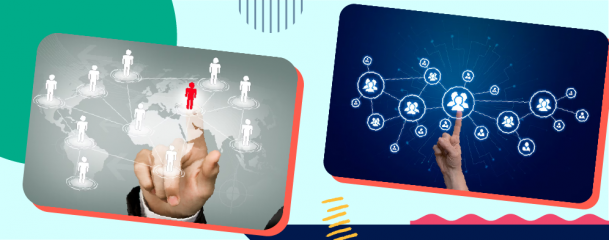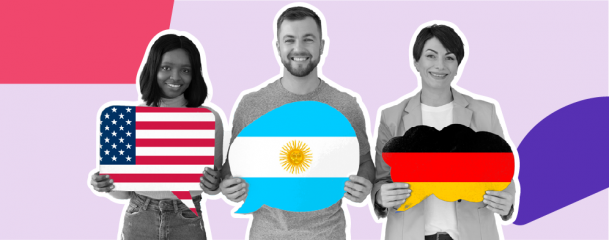1. What is Organizational Culture?
Organizational culture refers to a set of values, beliefs, behavioral traits and social interactions that defines the collective image of an organization. This is not a documented policy but a perceived reflection of an organization’s worth or identity. A positive organizational culture is typically rooted in best practices that leads to enhanced productivity, higher employee engagement and retention.
2. What is the Iceberg Model of Culture?

The iceberg model of culture is a detailed structure of parameters that helps you determine the quality of your organizational culture. Based on the analogy of an iceberg that has both a visible and hidden portion, this model assesses the effectiveness of an organization's visible and hidden cultural elements.
The visible section may include external aspects such as level of employee interactions, company attire, technologies used, and languages spoken. The hidden or internal aspects typically comprise beliefs, values, opinions, preferences and other intangible drivers that drive the organizational culture at a subconscious level.
3. Why is the Iceberg Theory Important to an Organization?
The iceberg model of culture or theory can be used as a standard to assess if your organization’s collective cultural values align with set goals and standards for effective growth. This is especially true when an organization is considering change management. The most important aspect of this is to understand how changes in mergers, policies, technology, hierarchy or goals can impact the culture of an organization and in turn employees
Instead of using benchmarks such as targets achieved, turnover, attrition rates and more, the iceberg cultural model explores unspoken reasons beyond the figures and feedback such as why employees are underperforming or leaving- is it due to inefficient work planning, micromanagement, workplace politics, lack of skills. For instance, when considering a new IT migration, a progressive organization would think it’s essential to understand what kind of changes employees are expected to make, how they accept these changes and if they are sustainable for growth. This promotes a more positive organizational culture.
4. What is the Iceberg Model in Leadership?
The iceberg model in leadership depicts the correlation between effective leadership, communication and enhanced productivity based on trust, transparency and flexibility. To ensure that employees adapt to change, stay proactive and work at their productive best, leaders need to identify not just tangible but unaddressed issues that can be a dampener as well.
5. Layers of Iceberg Model of Culture
5.1. Surface Level Culture
5.1.1. Dress code and appearance of employees

An employee dress code and overall appearance is a direct visual representation of an organization’s core mission and values as per the iceberg theory in organization and management. The manner in which employees are dressed can have quite an impact on how an organization’s culture is perceived. Think McDonalds for instance, you won’t find their employees flipping burgers in suits! They are dressed in business casual work attire that best represents the company’s value system. Another good example is organized workforces who wear uniforms which are a direct depiction of their collective value system and mission.
If your company believes in offering more flexibility and freedom for creative expression, chances are the attire will reflect that through its colors, prints and casual style. For companies who imbibe long-standing traditional work practices, the dress code would be more formal wear.
5.1.2. Technologies used in the company
How young, old, upcoming or rooted a company is can be easily ascertained by the kind of technologies they use. When using the iceberg model of culture, you can assess if a company is a new kid on the block, ready to experiment with the latest technologies, or a traditionally set unit that believes in using the simple basics. Companies who are tech-savvy and willing to embrace change can greatly impact organizational culture by creating the shift, engaging the workforce and attracting only those resources that are aligned with their value system.
For instance, if your company is pro collaboration and cross-communication, do they provide the necessary tools and resources such as Teams, Zoom, or Slack to support that for employees? Do they have the technology that can provide important information on team progress, goals met and overall growth stats- these are a few areas that can be explored for meaningful insights in the iceberg concept of culture.
5.1.3. Perks and Benefits
Employee perks and benefits can be a gamechanger since it’s employee-centric and a significant consideration to nurture and retain good talent in the iceberg model of communication. Organizations who aim to create a positive culture need to ensure that their employees are comfortable and happy. Flexibility in working from home, corporate team building activities, skill-enhancing workshops, or reimbursements can all impact employee behavior and their engagement at the workplace.
A point in case could be if your company offers tuition fee reimbursement, it speaks volumes on the importance they place on education, that they encourage learning and creates a unified message on their organizational culture.
5.1.4. Language Spoken

The crux of effective communication is language and that shapes your organizational culture. With the iceberg model, you can gain insights on how language is being used to communicate information in the company. What kind of language is used? What pitch and tone sets the premise for day-to-day work discussions. How choice of words, dialog delivery and gestures can influence how communication is received?
The iceberg theory in organization and management also works at the higher levels when it comes to wording information for policies, value statements, HR communication and more. A classic example of this was Facebook who previously chose the motto “Move Fast and Break Things” but later changed it to “Move fast with stable infrastructure” in a bid to reshape its cultural perception and operate differently.
5.1.5. Reward and awards
Whether it's a monetary raise, social media shout-out, food vouchers, or gift cards, any of these can be a big step in making employees feel valued and appreciated. The iceberg model of culture helps you assess what works for employee recognition at different levels be it social, monetary or verbal, how you can facilitate peer-to-peer recognition to boost a spirit of unity and more.
5.2. Deeper Level Culture
5.2.1. Authority and Accountability

Do your employees feel empowered to make decisions that can help them perform better? Are they given opportunities to express their opinions freely? Do they have the right tools and resources to be more proactive in problem solving ? These are essential factors that a company needs to consider in order to create an excellent organizational culture. Accountability needs to begin at the top with leaders, managers and team leaders.
When using the iceberg model of culture, you can explore how the company performs in this respect by finding out what kind of delegation system for work exists, are there any measures set for performance evaluation, what kind of programs are set in place for those who need it such as PIP or extended training sessions.
5.2.2. Health and Employee Wellness
A healthy work-life balance greatly influences productivity and employee happiness. This works well in creating a strong and healthy workforce culture. The bottom-line is reduced attrition and healthcare costs too. When employees are nurtured through a culture that endorses mental well-being, fitness and holistic living, it promotes more sustainable growth, company loyalty and success in meeting goals. Use the iceberg framework to find out the health index of your workforce, what health priorities mean to them and how the company can help them lead more healthy lives. This could be as simple as providing diet organic pantry snacks, arranging meditation or exercise workshops regularly or as advanced as integrating corporate wellness plans or programs into the system.
E-commerce firm, NextJump literally took the jump to prove that being small-sized should not be a barrier in looking out for its employees. Their wellness initiatives include healthy snacks, Psychological and emotional coaching programs, and a range of physical activities to choose from twice a week.
5.2.3. Purpose and Vision
Plum, for example, is a company whose mission is to harness the power of AI and analytics to help in getting the right jobs for enterprise talent. But the best bit is that they use the same tools to drive more employee engagement and optimize performance internally as well thereby interweaving their missions and long-term vision for the company.
5.2.4. Communication
Transparent communication is a hallmark of great organizational culture. Healthy and effective communication can open avenues for positive exchange of opinions, suggestions and ideas. It’s an ideal way to nurture company loyalty, reduce negativity, and boost productivity as well.
The iceberg model of culture addresses aspects of communication such as how often does the company facilitate open dialogs, team meetings, one-on-one sessions, feedback forums and more.
A company should leverage the use of technological platforms that aid in communication and collaboration as per the iceberg model of communication These should provide the necessary options for both the management and employees to engage in healthy oral or written communication for all organizational matters,
5.2.5. Employee Performance and Engagement
Take the case of Stagecoach, who integrated a mobile employee app for internal communication to ensure 20,000 bus and rail employees in the company can stay engaged and updated with news, updates and more.
5.2.6. Training and Development
Learning never stops and so your workforce needs to be constantly nurtured through effective training and development programs so they can be presented with challenging opportunities to grow individually and as a team. Proactive learning and development promotes a culture of innovation and creative thinking that provides new ways for a business to grow and stay ahead.
Companies who implement mentorship or learning and training programs to help individuals upskill and reskill, convey their commitment of helping their employees learn and grow, thereby increasing trust and motivation.
E-commerce giant, Amazon runs Amazon Technical Academy that implements various voluntary training programs to help non-technical employees upskill and re-skill in order to take up software engineering careers that will help them move upwards in their career graphs.
5.2.7. Collaboration and Teamwork
What level of collaboration and teamwork do your teams engage in? A positive organizational culture promotes cross-collaboration, teamwork, improves employee morale and helps in meeting goals. Unlike team building, teamwork puts collaboration and a spirit of competition in focus so they can work more effectively on projects, challenging assignments, and make operational decisions . By creating plans, strategizing and inviting collaboration at different levels, employees are empowered to get more creative and innovate. Ideas and information can be exchanged more easily across different functional departments, creating an overall positive impact on company performance.
With the iceberg model of culture, you can revisit the gaps if any, create more collaborative spaces, provide the right kind of tools and resources and equip employees with training if needed. Adobe is one such company that gets it right by encouraging employees or fellow Adobians to think out of the box, innovate and share their happy experiences in ‘Adobe Life’ using the hashtag #AdobeLife.
6. FAQs
6.1. What is the 90% part of the cultural iceberg?
90% of the cultural iceberg refers to all that remains hidden below the surface in terms of differences in values, opinions and assumptions among a collective group.
6.2. How is an iceberg related to culture?
Just like an iceberg has both a visible and hidden part below the surface, certain well-defined cultural aspects may be visible while there are other differences or dynamic aspects that cannot be seen or understood at one glance.
6.3. What does the cultural iceberg represent?
The cultural iceberg refers to visible and hidden parts of an organization, community or group. These external, seen or visible parts could be common attire, languages spoken, social interactions, while the internal, hidden or unseen parts include beliefs, values, personal views and more that impact human behavior.
 Interested in Virtual Team Building Events?
Interested in Virtual Team Building Events?





















